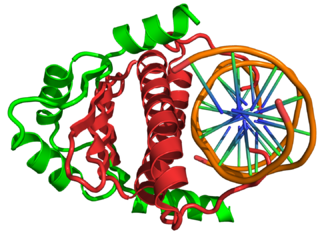Related Research Articles

Thrombospondins (TSPs) are a family of secreted glycoproteins with antiangiogenic functions. Due to their dynamic role within the extracellular matrix they are considered matricellular proteins. The first member of the family, thrombospondin 1 (THBS1), was discovered in 1971 by Nancy L. Baenziger.
CD98 is a glycoprotein that is a heterodimer composed of SLC3A2 and SLC7A5 that forms the large neutral amino acid transporter (LAT1). LAT1 is a heterodimeric membrane transport protein that preferentially transports branched-chain and aromatic amino acids. LAT is highly expressed in brain capillaries relative to other tissues.
Glia maturation factor is a neurotrophic factor implicated in nervous system development, angiogenesis and immune function. In humans, the glia maturation factor beta and glia maturation factor gamma proteins are encoded by the GMFB and GMFG genes, respectively.
The angiopoietin receptors are receptors that bind angiopoietin. TIE-1 and TIE-2 comprise the cell-surface receptors that bind and are activated by the angiopoietins,. The angiopoietins are protein growth factors required for the formation of blood vessels (angiogenesis).

In the field of molecular biology, myocyte enhancer factor-2 (Mef2) proteins are a family of transcription factors which through control of gene expression are important regulators of cellular differentiation and consequently play a critical role in embryonic development. In adult organisms, Mef2 proteins mediate the stress response in some tissues. Mef2 proteins contain both MADS-box and Mef2 DNA-binding domains.
The EGF module-containing Mucin-like hormone Receptors (EMRs) are closely related subgroup of G protein-coupled receptors (GPCRs). These receptors have a unique hybrid structure in which an extracellular epidermal growth factor (EGF)-like domain is fused to a GPCR domain through a mucin-like stalk. There are four variants of EMR labeled 1-4, each encoded by a separate gene. These receptors are predominantly expressed in cells of the immune system and bind ligands such as CD55.
The prokineticin receptor is a G protein-coupled receptor which binds the peptide hormone prokineticin. There are two variants each encoded by a different gene. These receptors mediate gastrointestinal smooth muscle contraction and angiogenesis.

Proto-oncogene tyrosine-protein kinase Src, also known as proto-oncogene c-Src, or simply c-Src, is a non-receptor tyrosine kinase protein that in humans is encoded by the SRC gene. It belongs to a family of Src family kinases and is similar to the v-Src gene of Rous sarcoma virus. It includes an SH2 domain, an SH3 domain and a tyrosine kinase domain. Two transcript variants encoding the same protein have been found for this gene.

Brain-specific angiogenesis inhibitor 1 is a protein that in humans is encoded by the BAI1 gene. It is a member of the adhesion-GPCR family of receptors.

Brain-specific angiogenesis inhibitor 2 is a protein that in humans is encoded by the BAI2 gene. It is a member of the adhesion-GPCR family of receptors.

Brain-specific angiogenesis inhibitor 3 is a protein that in humans is encoded by the BAI3 gene.

DNA-binding protein inhibitor ID-1 is a protein that in humans is encoded by the ID1 gene.

Homeobox protein Hox-A5 is a protein that in humans is encoded by the HOXA5 gene.

BAI1-associated protein 3 is a protein that in humans is encoded by the BAIAP3 gene.

Myelin transcription factor 1 is a protein that in humans is encoded by the MYT1 gene.

Serpin B13 is a protein that in humans is encoded by the SERPINB13 gene.

Potassium voltage-gated channel subfamily G member 3 is a protein that in humans is encoded by the KCNG3 gene. The protein encoded by this gene is a voltage-gated potassium channel subunit.

Potassium voltage-gated channel subfamily H member 3 is a protein that in humans is encoded by the KCNH3 gene. The protein encoded by this gene is a voltage-gated potassium channel subunit.
Pol refers to a gene in retroviruses, or the protein produced by that gene.
The prostaglandin E2 (PGE2) receptors are G protein-coupled receptors that bind and are activated by prostaglandin E2. They are members of the prostaglandin receptors class of receptors and include the following Protein isoforms:
References
- ↑ Shiratsuchi T, Nishimori H, Ichise H, Nakamura Y, Tokino T (1997). "Cloning and characterization of BAI2 and BAI3, novel genes homologous to brain-specific angiogenesis inhibitor 1 (BAI1)". Cytogenet. Cell Genet. 79 (1–2): 103–8. doi:10.1159/000134693. PMID 9533023.